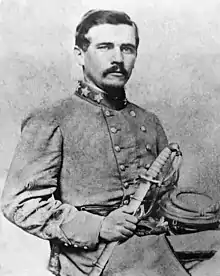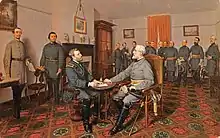Palmetto Sharpshooters
The South Carolina Palmetto Sharpshooters were a sharpshooter unit in the American Civil War. The regiment served with the Army of Northern Virginia from 1862 to 1865. The unit would fight in most of the major battles in the eastern theater, and experience hard fighting in the western theater with James Longstreet in 1863.

1862


The regiment would be formed from several South Carolina regiments near Richmond in early 1862. The regiment would be commanded by Micah Jenkins, and assigned to Richard Anderson's Brigade, Longstreet's Division, Magruder's Command. The regiments first action would be at the battle of Williamsburg in May 1862, the regiment would hold Fort Magruder against repeated Federal attacks, losing 29 men and withdrawing under the cover of night.[1] The unit would once again see heavy action at the battle of Seven Pines, May 31-June 1.[2] The Sharpshooters would assist in taking Casey's Redoubt, whipping Union General Darius Couch's division, and capturing several regiments in the process. 700 out of the roughly 1900 men in the brigade were killed or wounded. A few days prior to the engagement at Seven Pines General Longstreet had presented the Palmetto Sharpshooters with a battle flag, which the regiment carried into battle with them that day. The colour bearer would be shot during the assault; and as Colonel Jenkins rode past him he propped himself up on his elbows and exclaimed: "For God's sake, Colonel, take care of my flag!"[3][4]10 out of the 12 men in the colour guard would be shot down, with the flag changing hands 4 times in 3 minutes. At the battle of Gaines Mill the Sharpshooters would charge Union positions held by the 16th Michigan and the 82nd Pennsylvania capturing the 16th Michigan's colors, Colonel, and a number of men, but at the cost of several men killed and wounded.[5]
The actions at the battle of Glendale would be the next bloody test for the Palmetto Sharpshooters. The South Carolinians, along with the rest of the brigade, and supported by Wilcox's brigade, would charge across open fields towards Federal lines while taking heavy fire from the Pennsylvania Reserves and canister shot from Union batteries. Despite the volume of fire in their front, Jenkin's men would overrun Union artillery. The South Carolinians would be unable to proceed any further. And with the their supporting brigades being unable to hold their own gains, the whole brigade retreated back across the fields.[6] Private Richard L Williams of Company "L" would rescue the regimental colours and bring them back to friendly lines.[7] He then would take command of his Company and lead them forward with the flag. The entire South Carolina brigade would suffer harrowing loss, half of its number becoming casualties.[8] The Palmetto's would lose 255 men out of 375 on the field. Company "E" of the regiment would be devastated at Glendale, most of the Company becoming casualties, with only a few survivors.[9] The brigade would participate in the second Bull Run campaign and the Maryland campaign, repulsing Ambrose Burnsides attack south of Sharpsburg at the Battle of Antietam with heavy enlisted and officer loss. The regiment would not see any major actions during the battle of Fredericksburg.
1863
The Palmetto Sharpshooters went into the year 1863 a battered band of rebels, with Joseph Walker in command of the regiment. On March 17 the regiment would be attacked by the 11th Pennsylvania Cavalry and a battery, the Sharpshooters would lose several men wounded and captured. The Palmetto Sharpshooters would be sent to the western theater of the war, joining James Longstreet's army in Tennessee. The regiment would arrive too late to participate in the Battle of Chickmauga. During the battle of Wauhatchie,[10] the brigade, commanded by John Bratton, would take part in the night time attack on Federal positions near Lookout Mountain. Brattons brigade would assault John Geary's Union division, driving back skirmishers. The Palmetto Sharpshooters would take position on the left of the brigade, attempting to rout remaining Union regiments. However, the 149th New York would rally and hold off the Sharpshooters. After several hours of fighting the Confederate attack would be called off. 44 men would not return to their tents that night, including Major F.W. Kilpatrick, who was killed in the days fighting.
Shortly after the engagement at Wauhatchie, the regiment would be ordered to march on Knoxville with forces under General Longstreet. On November 13th, the regiment would secure a bridge site at Hough's Ferry on the Tennessee river, allowing a pontoon bridge to be constructed. During the Battle of Cambell's Station the regiment would play a supporting role in the attacks on Ambrose Burnsides Union forces. December would see the regiment in winter quarters, starving, and with their numbers greatly depleted after a long year of campaigning.
1864
The regiment would be sent east as General Ulysses S Grants Overland Campaign went underway. During the Battle of the Wilderness Jenkins brigade would be held in reserve during the actions against Winfield Scott Hancock's Union Second Corp. Longstreet would launch a counterattack which Jenkins brigade would be ordered to lead. However, the brigade would receive friendly fire from General William Mahone's Virginia brigade, wounding General Longstreet and killing Jenkins. The attack would be attemped again during the late afternoon, Jenkins’ Brigade, now under Colonel John Bratton of the 6th South Carolina Infantry, led the attack against the log fortifications lining the Brock Road. The attack would be repulsed, but a ferocious bush fire would in turn force the defenders back. Bratton's brigade took advantage of the breach and charged Union lines. However, Union artillery concentrated fire on the brigade, driving them back. At the Battle of Spotsylvania Court House Bratton's brigade and the Palmetto's would hold Laurel Hill and earthworks around the Mule Shoe against repeated Federal attacks. The next few weeks would see heavy fighting for the Palmetto's during the battles at the North Anna, Totopotomy, and Cold Harbor.[11]
Casualties for the Palmetto's during the Overland Campaign numbered (Note: Casualty figures may be off, as Confederate reports are really scarce, and sometimes not written.):[12]
- Wilderness: 8 killed, 65 wounded, Spotsylvania Courthouse: 3 killed, 31 wounded
- North Anna: 1 killed, 3 wounded, Totopotomy: 2 killed, 3 wounded
- Cold Harbor: 3 killed, 8 wounded, 3 missing
The Palmetto Sharpshooters and Brattons brigade would be sent south of Richmond to Petersburg, where they would hold Battery 34 against Union General Gouverneur K. Warren's V Corps. Throughout the long Siege of Petersburg the regiment would fight in such battles as 2nd Deep Bottom, Halifax Road, and Fort Harrison. At the battle of Darbytown Road, the brigade would assault Federal positions suffering heavily in the process. On December 25 the regiment went into winter quarters. 1864 was a rough year for the sharpshooters, losing Jenkins, who had been their original Colonel the since the beginning of the war, and a number of officers.
1865

The Palmetto Sharpshooters would miss the actions during the breakthrough at Petersburg, and would frankly not see any more major actions for the rest of the war. The South Carolina Palmetto Sharpshooters surrendered at Appomattox Court House with the rest of the army on April 9, 1865. The regiment was the largest one in the army at the time of the surrender, numbering 29 officers and 356 men, commanded by Colonel Joseph Walker.[13][14][15][16]Ironically, the South Carolinians shared rations and shook hands with the 16th Michigan, whose colors they had captured at Gaines Mill, two years ago.[17] The regiment would stick together on its march to South Carolina, and would disband once they reached said state. The total casualty figures for the Palmetto Sharpshooters are unknown.
"Sharpshooters"
The name "Palmetto Sharpshooters" implies that the unit was a marksmen unit. However, the regiment would frequently act as an infantry line regiment, rather then a skirmish unit. And the soldiers in the regiment were not handpicked marksmen like Hiram Berdan's Union Sharpshooters; the regiment being formed hastily from soldiers from the other regiments in the brigade. The Palmetto's would be equipped with Whitworth Rifles, generally considered the first modern sniper rifle. It is not to say that the regiment did not perform any "sharpshooting" actions during the war; many times during the campaigns the regiments Whitworths would be put to good use.
Further reading
- Baldwin, James J. The Struck Eagle: A Biography of Brigadier General Micah Jenkins, and a History of the Fifth South Carolina Volunteers and the Palmetto Sharpshooters. Burd Street Press, 1996.[18]
- Rigdon, John C. Historical Sketch And Roster Of The South Carolina Palmetto Sharpshooters (South Carolina Regimental History Series). Independently published. 2019.[19]
- The Palmetto riflemen : Co. B., Fourth regiment S.C. Vols. Co. C., Palmetto sharp shooters : historical sketch / an address delivered by James A. Hoyt.[20]
References
- "Palmetto (South Carolina) Regiment Sharpshooters". The Civil War in the East. Retrieved 2022-11-26.
- "Seven Pines Confederate order of battle", Wikipedia, 2022-11-04, retrieved 2022-11-26
- "Longstreet's Aide: The Civil War Letters of Major Thomas J Goree (A Nation Divided: Studies in the Civil War Era): 9780813915746 - AbeBooks". www.abebooks.com. Retrieved 2023-07-09.
- Thomas, John Peyre (1903). Career and character of General Micah Jenkins ... Columbia, S.C.: The State Company.
- "Seven Days Confederate order of battle", Wikipedia, 2022-11-21, retrieved 2022-11-26
- "StackPath". www.essentialcivilwarcurriculum.com. Retrieved 2023-01-05.
- "The weekly telegraph. (Macon, Ga.) 1885-1899, February 14, 1888, Image 11 « Georgia Historic Newspapers". gahistoricnewspapers.galileo.usg.edu. Retrieved 2023-08-30.
- "Longstreet's Aide: The Civil War Letters of Major Thomas J Goree (A Nation Divided: Studies in the Civil War Era): 9780813915746 - AbeBooks". www.abebooks.com. Retrieved 2023-07-09.
- "The Watchman and Southron 01 Jul 1884, page Page 1". Newspapers.com. Retrieved 2023-07-07.
- "Wauhatchie Confederate order of battle", Wikipedia, 2021-08-14, retrieved 2022-11-26
- "Wilderness Confederate order of battle", Wikipedia, 2022-11-04, retrieved 2022-11-26
- United States; Cowles, Calvin D.; Moodey, John S.; Ainsworth, Fred C.; Kirkley, Joseph W.; Perry, Leslie J; Davis, George B.; Lazelle, H. M.; Scott, Robert N. (1880–1901). The War of the Rebellion: a compilation of the official records of the Union and Confederate armies. Washington: Govt. Print. Off.
- "Appomattox campaign Confederate order of battle", Wikipedia, 2022-11-28, retrieved 2023-01-05
- Siege, Petersburg (2010-06-14). "865bi: Confederate Army of Northern Virginia 28 February 1865". The Siege of Petersburg Online. Retrieved 2023-07-07.
- "Palmetto Sharpshooters Regiment, South Carolina (Jenkins') (1st Palmetto)". www.familysearch.org. Retrieved 2023-08-30.
- "The Appomattox Roster - Research OnLine". www.researchonline.net. Retrieved 2023-08-30.
- "The Watchman and Southron 01 Jul 1884, page Page 1". Newspapers.com. Retrieved 2023-07-07.
- "9781572490178: The Struck Eagle: A Biography of Brigadier General Micah Jenkins, and a History of the Fifth South Carolina Volunteers and the Palmetto Sharpshooters - Baldwin, James J., III: 1572490179 - AbeBooks". www.abebooks.com. Retrieved 2023-02-08.
- "9781096427964: Historical Sketch And Roster Of The South Carolina Palmetto Sharpshooters (South Carolina Regimental History Series) - Rigdon, John C.: 1096427966 - AbeBooks". www.abebooks.com. Retrieved 2023-02-08.
- "Page 22". digital.tcl.sc.edu. Retrieved 2023-08-29.